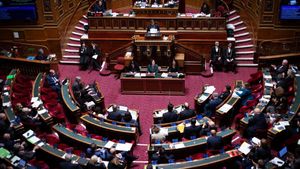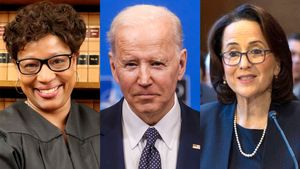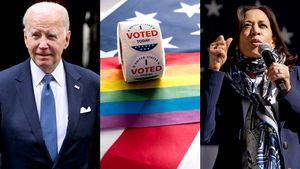The Trump administration has escalated its efforts to purge transgender service members from the military, urging them to voluntarily separate by March 26—or face an uncertain future.
Keep up with the latest in LGBTQ+ news and politics. Sign up for The Advocate's email newsletter.
The directive, outlined in a March 1 memorandum from the Department of the Air Force, was filed Sunday in the U.S. District Court for the District of Columbia as part of Talbott v. Trump, a legal challenge brought by GLAD Law and the National Center for Lesbian Rights. The memo, signed by Acting Assistant Secretary of the Air Force for Manpower and Reserve Affairs Gwendolyn R. DeFilippi, states that individuals with gender dysphoria are “incompatible with the high mental and physical standards necessary for military service.”
Related: BREAKING: Trump administration admits to judge it doesn’t know how many troops are trans—or why it’s banning them
Transgender service members “are encouraged to elect to separate voluntarily no later than 26 March 2025,” the memo states. “Service members eligible for voluntary separation pay will be paid at a rate that is twice the amount for which the service member would have been eligible under involuntary separation pay.” The memo applies explicitly to Air Force and Space Force members, though other branches are expected to follow suit.
The document also confirms that previous waivers allowing them to use facilities and grooming standards consistent with their gender identity have been revoked effective immediately. Transgender personnel must now adhere to so-called “biological sex” standards for uniforms, grooming, fitness requirements, and access to showers, bathrooms, and lodging, it notes.
This ultimatum comes just one day after the administration admitted in court that the Department of Defense does not track service members by gender identity and has no clear idea how many transgender people actually serve. Despite this, it has moved aggressively to implement President Donald Trump’s January 27 executive order, “Prioritizing Military Excellence and Readiness,” which charged Defense Secretary Pete Hegseth with coming up with policies to eliminate transgender people from military service under the guise of “readiness.”
Among other restrictions, the March 1 memo also halts access to gender-affirming medical care, though it permits ongoing hormone therapy “to prevent further complications” while service members await separation. Those who do not leave voluntarily face an uncertain administrative process with no guarantee of retention or protection from involuntary discharge.
The administration’s own data undermines the rationale for this ban. According to the government’s previous court filing, a Congressional Research Service report indicates that between January 2016 and May 2021, only 1,892 active-duty troops received gender-affirming care—a fraction of the 1.3 million service members. Additionally, the Pentagon has admitted in court that it does not have reliable estimates on how many transgender people are serving.
The filings come as part of a mandatory disclosure order from U.S. District Judge Ana Reyes, who, on February 5, ordered the administration to provide all policies and guidance related to Trump’s anti-trans executive orders. The March 1 memo is the latest in a series of documents that outline the administration’s rapid and aggressive implementation of its ban on transgender service members.
SPARTA Pride—which represents transgender troops—emphasized that transgender people serve in critical roles across the military and that banning them will only weaken the U.S. Armed Forces.
On March 12, Reyes will hear arguments from GLAD Law and NCLR seeking an emergency injunction to block the policy, which, NCLR legal director Shanon Minter told The Advocate in a statement, would “ensure that transgender troops who meet every qualification to serve can continue their commitment to serving our country.“



















































































